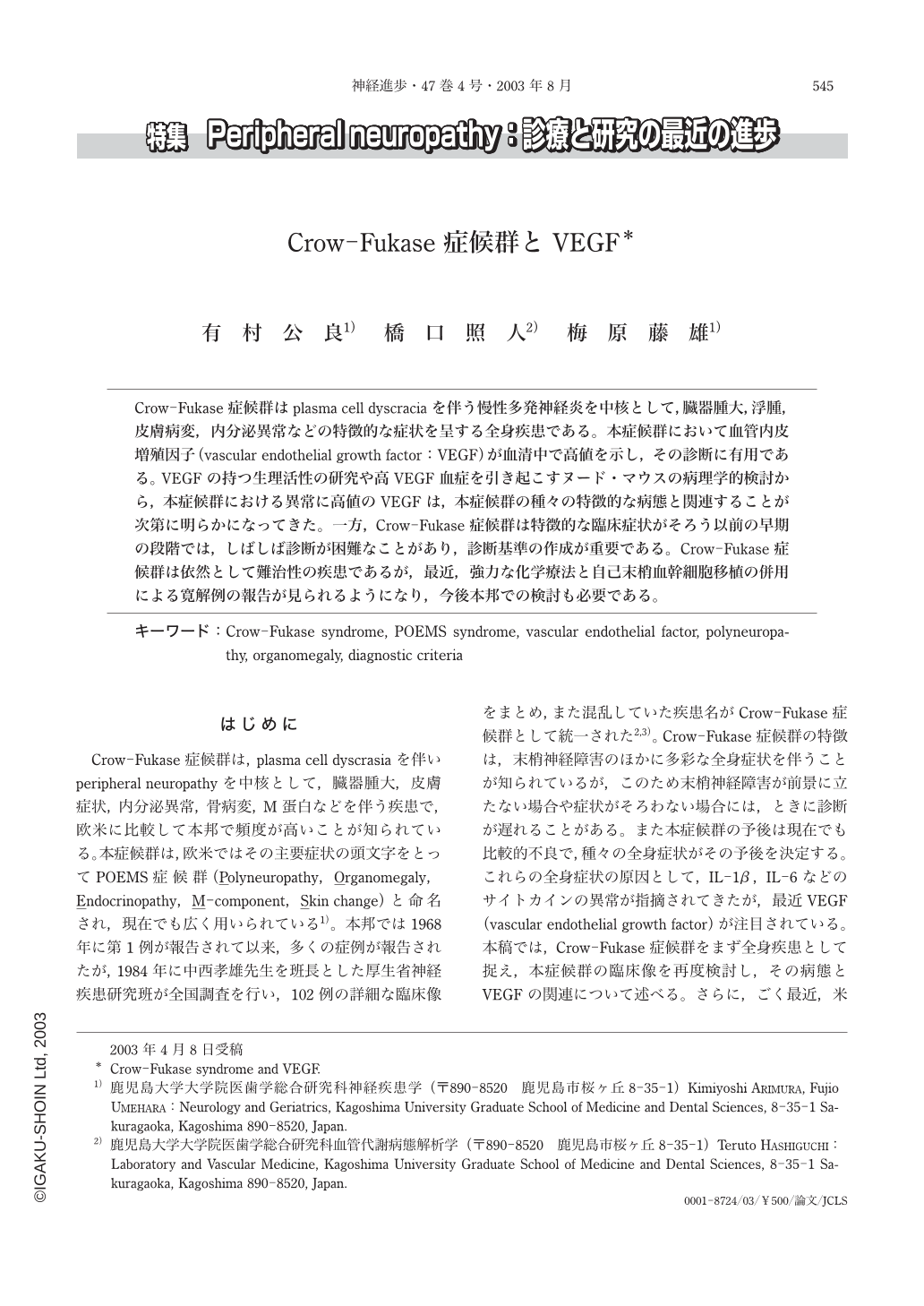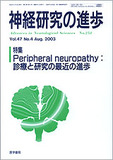Japanese
English
- 有料閲覧
- Abstract 文献概要
- 1ページ目 Look Inside
Crow-Fukase症候群はplasma cell dyscraciaを伴う慢性多発神経炎を中核として,臓器腫大,浮腫,皮膚病変,内分泌異常などの特徴的な症状を呈する全身疾患である。本症候群において血管内皮増殖因子(vascular endothelial growth factor:VEGF)が血清中で高値を示し,その診断に有用である。VEGFの持つ生理活性の研究や高VEGF血症を引き起こすヌード・マウスの病理学的検討から,本症候群における異常に高値のVEGFは,本症候群の種々の特徴的な病態と関連することが次第に明らかになってきた。一方,Crow-Fukase症候群は特徴的な臨床症状がそろう以前の早期の段階では,しばしば診断が困難なことがあり,診断基準の作成が重要である。Crow-Fukase症候群は依然として難治性の疾患であるが,最近,強力な化学療法と自己末梢血幹細胞移植の併用による寛解例の報告が見られるようになり,今後本邦での検討も必要である。
はじめに
Crow-Fukase症候群は,plasma cell dyscrasiaを伴いperipheral neuropathyを中核として,臓器腫大,皮膚症状,内分泌異常,骨病変,M蛋白などを伴う疾患で,欧米に比較して本邦で頻度が高いことが知られている。本症候群は,欧米ではその主要症状の頭文字をとってPOEMS症候群(Polyneuropathy,Organomegaly,Endocrinopathy,M-component,Skin change)と命名され,現在でも広く用いられている1)。本邦では1968年に第1例が報告されて以来,多くの症例が報告されたが,1984年に中西孝雄先生を班長とした厚生省神経疾患研究班が全国調査を行い,102例の詳細な臨床像をまとめ,また混乱していた疾患名がCrow-Fukase症候群として統一された2, 3)。Crow-Fukase症候群の特徴は,末梢神経障害のほかに多彩な全身症状を伴うことが知られているが,このため末梢神経障害が前景に立たない場合や症状がそろわない場合には,ときに診断が遅れることがある。また本症候群の予後は現在でも比較的不良で,種々の全身症状がその予後を決定する。これらの全身症状の原因として,IL-1β,IL-6などのサイトカインの異常が指摘されてきたが,最近VEGF(vascular endothelial growth factor)が注目されている。本稿では,Crow-Fukase症候群をまず全身疾患として捉え,本症候群の臨床像を再度検討し,その病態とVEGFの関連について述べる。さらに,ごく最近,米国から出された本症候群の診断基準と対比する形で,本邦における診断ガイドラインの私案を示す。
Crow-Fukase syndrome is diagnosed by the presence of chronic sensori-motor polyneuropathy occurring with other characteristic generalized symptoms that go by the acronym of POEMS. In this syndrome, vascular endothelial growth factor in serum is abnormally elevated and is predictive of the diagnosis. In circulating blood, VEGF is specifically stored in platelets and released during platelet aggregation. VEGF is known to upregulate the expression of tissue factor and to induce hyper-coagulability. Highly concentrated VEGF in platelets may be released in massive amounts due to coagulation in the peripheral tissue thereby reinforcing its physiological potency. The correlation between polyneuropathy and elevated VEGF is not yet well understood. VEGF may affect the blood-nerve barrier by increasing microvascular hyper-permeability thereby causing intraneural edema and subsequently increasing endothelial pressure. VEGF may upregulate other cytokines such as matrix metalloproteases and induce blood-nerve barrier breakdown and demyelination of the peripheral nerve. In order to study the correlation between VEGF and the other generalized manifestations, we transplanted VEGF secreting tumors in nude mice and studied the pathological findings in these mice. Prominent edema with elevated serum VEGF was found. Organomegaly was also found in the liver, spleen and kidney. Pathological findings in these organs were similar to those found in autopsies of CFS patients. These findings suggest that elevated VEGF may be closely correlated with generalized edema(anasarca). However, it is also important to consider factors such as cytokines and other T cell functions that, in association with VEGF, may be the cause of neuropathy in CFS. For effective and early treatment, diagnostic criteria for the Crow-Fukase syndrome will be needed.

Copyright © 2003, Igaku-Shoin Ltd. All rights reserved.


